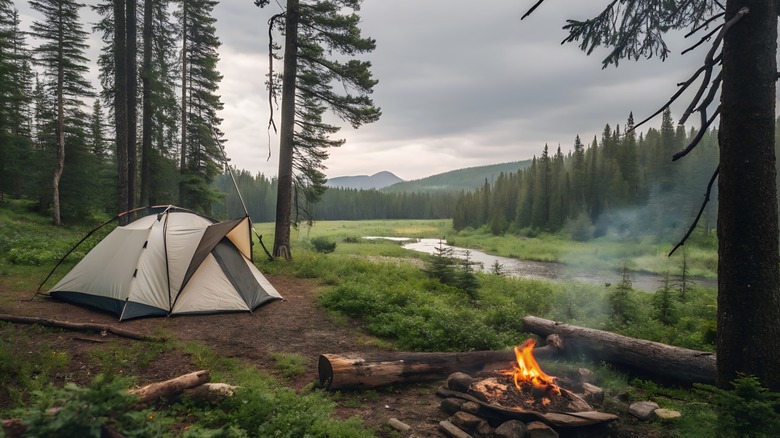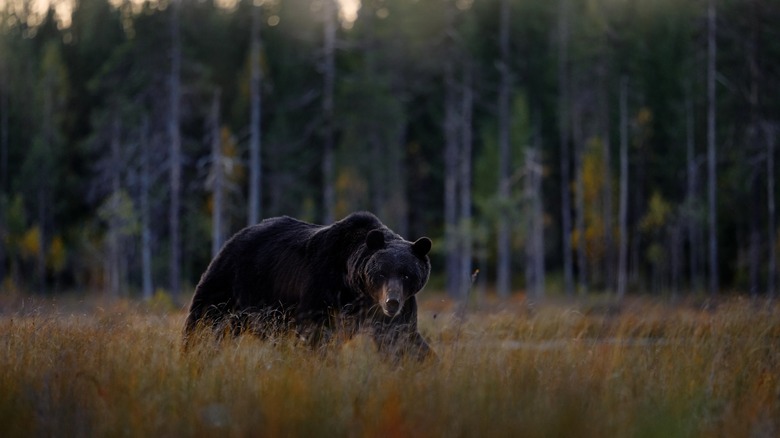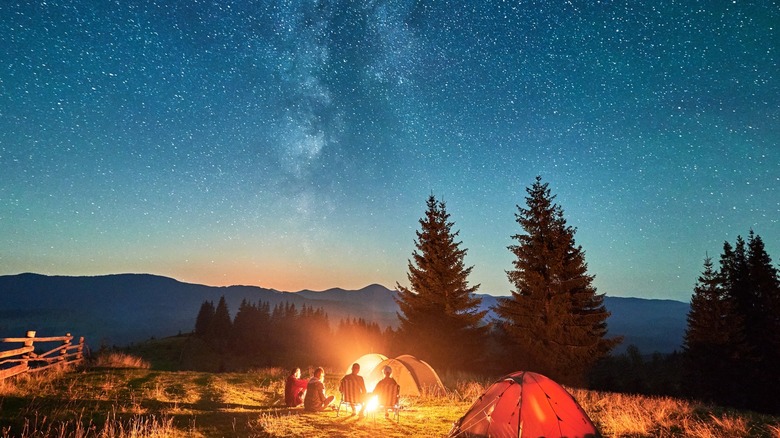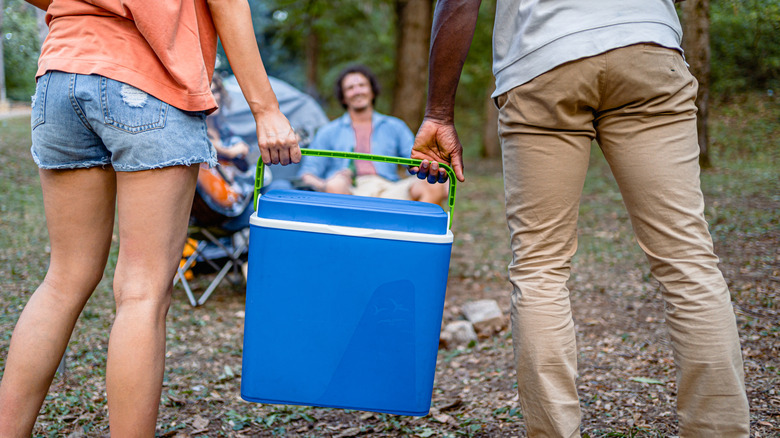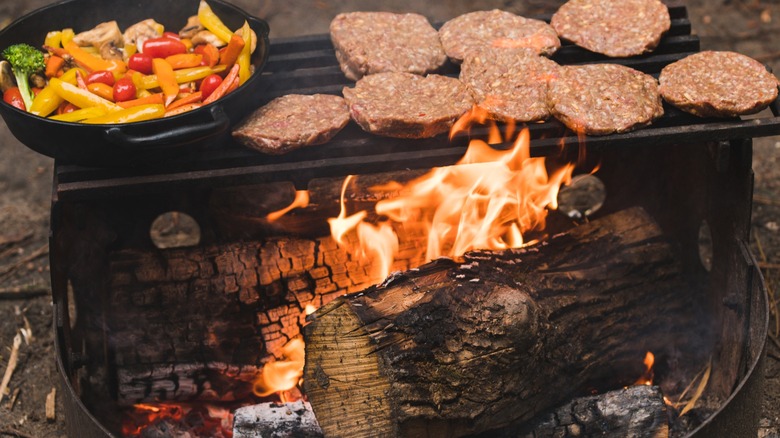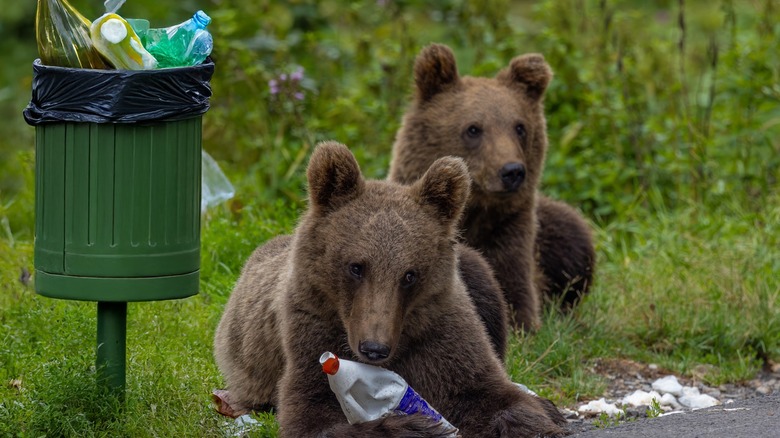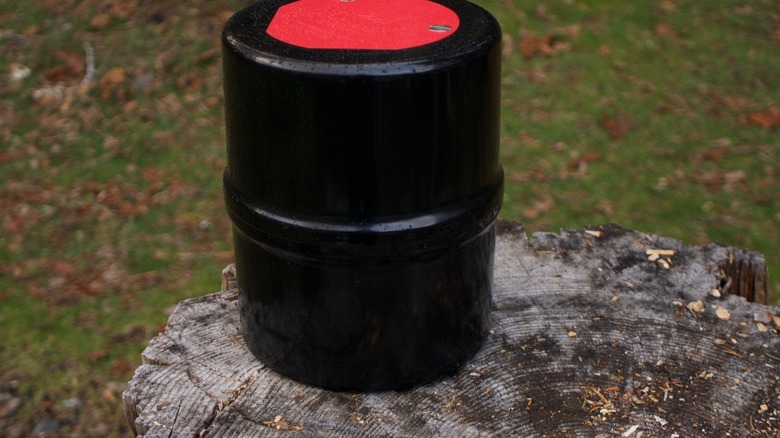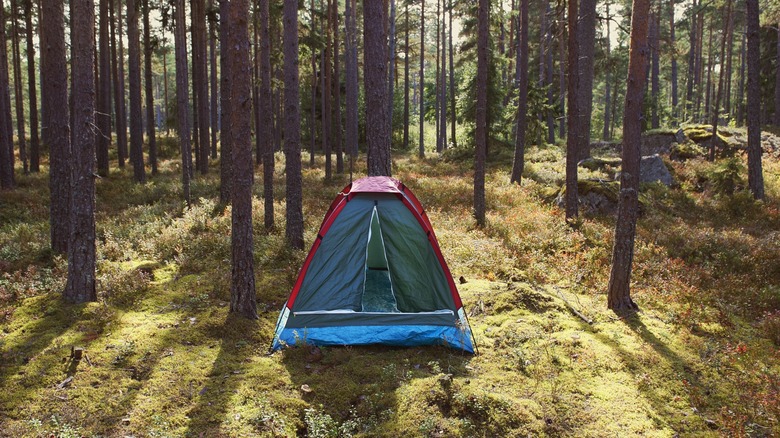How To Properly Bear-Proof Your Campsite
Preparing for a wilderness camping trip takes more than just a sense of adventure; it requires awareness and planning, especially in bear territory. Camping among wildlife offers an incredible chance to experience nature up close. However, safety should always come first.
Bears are naturally curious and have an extraordinary sense of smell. Even a small mistake, such as leaving food unattended or cooking too close to the tent, can attract them to campsites. Worldwide, a study in Scientific Reports (via Nature) reported 664 brown bear attacks between the years 2000 and 2015. By following a few key steps, campers can significantly reduce the risk of an encounter. Choosing a safe campsite, storing food properly, and keeping the area clean are all essential for preventing unwanted visits.
Plus, being mindful of these practices not only protects people but also safeguards the bears themselves. Responsible camping helps to preserve not only the scenery, but also the natural behavior among wildlife. And, in turn, this also ensures that future visitors can enjoy the outdoors safely. With the right preparation, campers can experience the quiet beauty of nature without any late-night surprises.
Why it's important to bear-proof your campsite
Bear-proofing your campsite is one of the most important steps to staying safe in bear country. In general, bears typically prefer to avoid people. The best way to prevent bear encounters is "bear-proofing," meaning you should store all food, trash, toothpaste, and other strongly-scented items in places where bears cannot reach them.
The National Park Service (NPS) explains that when bears eat human food, they can lose their natural fear of people and begin to rely on campsites for food. When bears learn to scavenge human food, it puts both the campers and wildlife at serious risk. Over time, these bears may become aggressive and unpredictable, posing serious risks to campers and property. In addition, Colorado Parks and Wildlife reports that the majority of bear conflicts can be traced back to improperly-stored food or trash. Kerry Gunther, a bear biologist, stresses on the NPS website that storing food correctly is one of the most important steps that campers can take to keep bears and other wildlife from associating humans with easy meals.
According to data provided by the World Population Review, the United States is home to approximately 479,000 black bears spread across 37 states. The largest populations are found in Alaska, California, Maine, Idaho, and Oregon. As for grizzlies, there are about 50,000 in the U.S., according to the U.S. Fish & Wildlife Service. Canada has the highest black bear population in North America, with estimates around 380,000 of the some-600,000 found in North America (via Parks Canada). Of course, they're not found everywhere, so if you're visiting the storybook seaside village Prince Edward Island, you'll be far away from any bears.
Choose a safe campsite
When camping in bear country, choosing the right campsite is your first line of defense. Select an open area away from too many trees, bushes, and thick greenery where bears can hide or travel on so you have enough visibility to avoid possible encounters. It's also good to avoid sites that show signs of bear activity, such as disturbed plant life, rocks, or logs on the ground (including claw marks) or bear droppings.
Bears are naturally attracted to food and areas near water, so it's best to avoid camping near berry bushes, fruit trees, rivers, or streams. While these scenic spots may seem ideal, they are often the same areas where bears forage and travel. Enjoy these places during daylight hours, but set up camp in a safer, more open area when evening comes.
Before making a reservation, plan ahead and choose a campsite that offers you everything you need to camp safely, including the criteria above. Also, avoid pitching your tent near dumpsters or trash bins since strong food smells can attract bears from a surprising distance. By carefully selecting your campsite, you reduce the chance of unexpected wildlife encounters and create a safer environment for both campers and animals.
Store food strategically to keep bears away
Improper food storage is usually the cause of bear encounters in parks and campgrounds. As mentioned before, bears have incredibly sensitive noses. According to Knau.org, an NPR affiliate in Arizona, a bear's sense of smell is estimated to be 100 times stronger than a dog and more than 2,000 times better than a human. Even the faint scent of food, gum, soap, or toothpaste can draw a curious bear into camp. So, the goal of proper storage is not only to protect your provisions but also to deter wildlife who might smell your food.
Before heading into the wilderness, organize all food items and supplies. Store meals in airtight or vacuum-sealed bags to reduce scent, and avoid bringing foods with strong odors or sugary treats unless they can be stored correctly. Bring only what you plan to eat to avoid leaving leftovers that could become a temptation.
The NPS emphasizes that effective food storage starts with preparation and awareness. Keeping a clean, scent-free campsite also protects and preserves the bears that inhabit the area. In some national and state parks, proper food storage is not just recommended — it's required by law. There are numerous regulations across different states that can affect how visitors can camp and enjoy public lands, which serve as prime habitat for bears.
Keep the campsite clean and scent-free (including non-food items)
Keeping a generally clean campsite is also one of the most effective ways to avoid attracting bears. Bears rarely enter camps just out of curiosity. Even small, non-food items like toothpaste, unwashed dishes, or spilled drinks can release strong scents that carry for miles to a bear's nose, piquing their interest. Maintaining a tidy campsite shows respect for nature and removes any reason for a bear to investigate.
Organization is key. In addition to food, store all trash, and scented items such as deodorant, lotion, or candles well away from sleeping areas. The only scents in the air should be pine trees and campfire smoke. Many experts recommend creating separate zones for cooking, eating, bathing, and sleeping to reduce odors and confusion. Wipe down tables and cooking surfaces after meals, and if you've cooked over a fire pit, cover it with dirt to mask food smells. Never leave dirty dishes or utensils out overnight, and remember the unwritten rules for using soap on a camping trip.
Proper waste management is equally important. Campgrounds and park rangers constantly remind visitors to dispose of garbage correctly. Burying food scraps is ineffective since bears can easily dig them up. Burning waste isn't recommended either, and the U.S. Forest Service advises against it because the lingering smell can also attract wildlife. Instead, pack out all trash or use designated bear-resistant disposal bins. Even small actions matter. Dishwater, toothpaste, and other scented liquids should be diluted with water and poured far from camp. These steps help ensure your campsite stays clean, scent-free, and safe for both campers and bears.
Cook at a safe distance
Cooking in bear country requires careful planning and awareness as well. The way you pack and prepare your meals can either keep bears away or draw them toward your campsite. Safe cooking depends not only on what you make but also on where and how you prepare it.
Experienced campers and wildlife experts recommend keeping cooking sessions short and simple. The longer food is heated, the more scents travel through the air. To limit odors, plan quick, low-odor meals and skip strongly scented foods such as bacon, tuna, or steak. Instead, choose options like oatmeal, cereal, peanut butter sandwiches, pasta, or sealed canned and dehydrated meals. These choices stay contained and release minimal scent when prepared. Some campers prefer to eliminate cooking smells entirely by following a no-cook meal plan. Easy options include bagels with cream cheese, ready-to-eat snacks, or "just add water" camping meals available at most outdoor stores. They're convenient, lightweight, and reduce the chances of attracting wildlife.
If you plan to cook, do so when bears are less active. Bears are most active at both dawn and dusk, so cooking outside of these times and keeping your area organized helps reduce the risk of an encounter. With careful planning and smart meal choices, campers can enjoy hot meals in the wilderness without inviting unwanted visitors. A little preparation goes a long way toward ensuring a safe and peaceful backcountry experience.
Hang a bear bag correctly
Bear bagging is a method for hanging food and scented items out of reach of bears and other wildlife. To do this, first place all food, trash, and scented items into a single bag. Many outdoor stores sell bags specifically for this purpose. Attach the bag to a length of lightweight but strong rope or cord, tying one end to the bag (you can secure it with a carabiner) and the other to a palm-sized stone.
Knowing how to properly hang a bear bag is an essential camping skill. As recommended by The Washington Trails Association, you should choose tree no less than 200 feet from your tent with limbs that are about 15 feet off the ground and stretching at least 10 feet from the trunk. This ensures that your bag stays well out of reach of both bears on the ground and any that might try to climb. Tie one end of your rope to a stone and toss the other end (with the bag) over the branch so the line drapes across it. Once the rope is in place, use the other end to pull your food bag up, then tie it securely to the tree trunk.
Test the stability by giving the bag a firm tug to make sure the knot holds and the branch is solid. If the branch bends or cracks, its time to choose another tree. If the bag is still reachable for potential bears, raise it higher or move it further from the trunk. When night falls and bears roam, you'll rest easier knowing your meals are secure and you're prepared for camping anywhere in bear country.
Use a bear box properly
Many national parks across America and more established campgrounds provide bear boxes. Bear boxes are secure containers designed to prevent bears and other wildlife from accessing campers' food, trash, and other supplies while in bear territory. "Having all these bears that were conditioned to human foods, getting fed by visitors ... also led to a lot of bear-human conflicts," states Yellowstone's bear biologist Kerry Gunther in a video on the NPS website, detailing how the Yellowstone's bear management program came to be — including the installment of bear boxes.
However, a bear box is only effective if used correctly. Many campers make the mistake of just tossing food inside without sealing or organizing it properly, which kind of defeats the purpose. Start by placing all scented items inside the bear box — not just food. This includes drinks, cooking oil, trash, pet food, non-food items, and even unopened cans or bottles. Anything with a smell, no matter how faint, belongs in the box. The NPS recommends observing this simple rule: "If you put it in your mouth or on your skin, it should probably be stored in a bear box or canister."
Once everything is inside, make sure the lid is latched or locked. Bear boxes are designed with special latches that are easy for humans to open but nearly impossible for bears. If you decide to stay in your car, here are more safety tips to keep bears away while car camping.
Bring a bear canister if you don't have a bear box
Unfortunately, bear boxes are expensive, often costing over $2,000. Due to this, many campsites might not have them available. But don't worry — bear canisters are a convenient and safe alternative that can be easily purchased. There is also a right way and wrong way to use a bear canister, so it's important to follow the correct steps while camping.
Start by keeping distance in mind. Prepare food, eat, and store your canister at least 100 yards downwind from your tent because where you sleep should be out of the way of cooking and food odors that may drift on the wind during the night. Once you're done eating, stash your canister on the ground, tucked behind rocks or brush, where it's less visible to wandering bears. Avoid water like lakes, streams, cliffs, or rivers when placing your canister. Bears might nudge the container down a hill or into a stream. Choosing a flat, sheltered spot ensures it's still waiting in the morning.
Remember to always keep the canister closed and locked, even when you're nearby since undoing the lid can release scents into the area, drawing a hungry bear out of hiding. Finally, your canister should not have ropes or cords wrapped around it since this offers the bear and easy way to drag it off into the wilderness. Instead, leave it free-standing and secure in a stable location. When used properly, canisters can be an effective tool for bear-proofing your campsite.
Bring other essential gear for bear-safe camping
These are some of the best items I would recommend packing for safe camping in bear country. These items can be the difference between a quiet weekend getaway and a bear disaster. One item that's commonly recommended is bear spray, since it can often ward off bear attacks if you're coming into close quarters with one. According to research entitled "Efficacy of Bear Deterrent Spray in Alaska," shows that using bear spray protected people from serious injury or death more than 90% of the time. Bear spray is a must-pack for camping and hikes in bear territory.
Bear-proof coolers are a also a great alternative to bear boxes or canisters, especially for car campers and RV travelers. The Interagency Grizzly Bear Committee (IGBC) has a certified product list of these coolers that feature reinforced walls, sturdy hinges, and latches that are lockable and can withstand a bear's strength and intelligence. And if you want to bring toiletries while camping, consider finding fragrance-free versions of your favorite soaps, lotions, and lip balm.
Although it's sometimes considered a rather aggressive option, if camping in bear territory doesn't go according to plan, you should be prepared with an air horn as an extra line of defense. A typical air horn designed for bear safety can emits sounds at about 115 decibels but these should be used from a distance to scare off any potential bears before you encounter then, not to honk it directly at the bear. There are, of course, other items you'll want for an easy camping retreat as well.
Be hyper-aware of bears in spring and fall
Outdoor enthusiasts are often tempted to start camping as soon as the weather gets warmer, but be aware that bears' behavior and activity levels can vary by the season. In Yellowstone National Park during the spring season, both black and grizzly bears emerge from hibernation and are often seen foraging in meadows and valleys. Bears are reportedly particularly active during this time of year because they need food after months of hibernation. Fall is another peak activity time when bears enter hyperphagia, a phase of constant feeding to beef up their fat reserves for the long winter ahead. During these periods, bears are typically most active during the early morning and late evening hours. These cooler times of day are when you are most likely to encounter a bear as they forage for food.
Although spring and fall are slightly more busy for the bears, these animals will still be active in summer too. Plus, the period of hibernation can change from region to region. In places like Florida, bears technically don't hibernate that long (or sometimes at all) other than potentially mother bears and their cubs, though it's for shorter times. In northern areas, harsher winters make hibernation essential for the bears' survival, but the exact times of hibernation are always changing. In places like Yellowstone National Park, depending on the conditions, bears might go into hibernation in November and not emerge again until March or even as late as May.
Essentially put, there's no time of year that's entirely bear-free, but understanding these seasonal patterns helps campers anticipate bear activity and plan safe camping practices accordingly. Now that you're ready for camping in bear country these are the best national parks that are free to enter.
